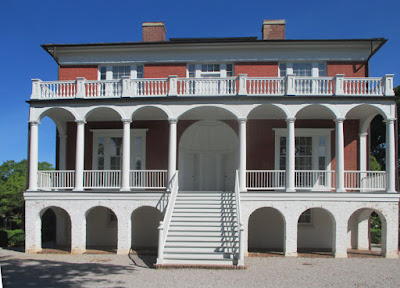Basted chintz quilt piece
Historic Columbia Foundation.
We went to Columbia, South Carolina to see some quilts at the
Historic Columbia Foundation.
We were particularly interested in this unfinished piece in their collection.
The floral arrangement in the center is cut from Panel #2
Complete panel in the collection of the Winterthur Museum
The floral sits in a woven basket and more roses have been added from another chintz to give the bouquet a naturalistic look with buds sprouting along the edge.
Bouquets cut from that same rose chintz frame the
center.
I had to photostitch two pictures together to give you an overall view
of the rectangular piece, which seems to have been meant for the center
of a characteristic Carolina chintz spread.
It's all nicely basted in place. All you'd have to do
is trim away the background and applique the roses.
The woven basket even has the edges turned under for you.
Our hypothesis is that the piece was designed, cut and basted by a professional seamstress who sold kits to needleworkers who would then finish the applique fairly quickly and add some borders for a gorgeous spread.
Two-person collaboration was probably quite common in 19th-century applique, for example in the Baltimore Album blocks of the 1840s' and '50s.
City Springs basted block
Collection of the Maryland Historical Society
And probably many other styles of applique.
Trimming the floral background away in the panel would be no problem; the background was white. But trimming the background in the rose details was definitely a problem.
The background there was what was called a fancy machine
ground by the printers. You had to trim extremely close to eliminate
the dot pattern.
Which can be done.
That grape tendril in a panel #5 quilt has been trimmed minutely.
Maybe the purchaser just never got around to trimming.
Whatever the reason we're grateful to find a basted center,
giving us a clue to how these bedcovers were made.
The picture files do not contain many panel bouquets in baskets.
But about a hundred miles away the Spartanburg County History Museum
has a very similar composition in their collection.
This one is a finished quilt with the same Panel #2
growing from a woven, flat basket.
Additional flowers have been added around the circular panel.
Adding to the idea that these were basted and sold as kits of some kind
What Have We Learned from this Piece?
The basted center adds much to our hypothesis that many chintz panel quilts in the South were designed, cut and basted by professional seamstresses. Some hobbyists finished the applique and had them quilted, but others bought the finished bedcovers from those same workshops. We still are looking for evidence of these invisible seamstresses---the designers who supervised and the women who stitched.






















Quite the find!
ReplyDelete